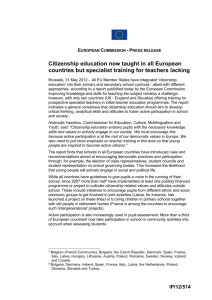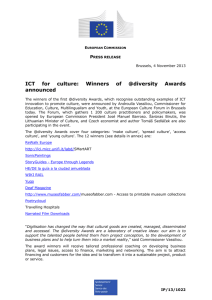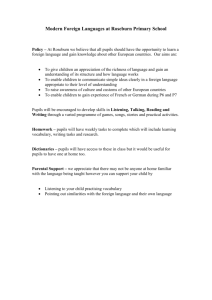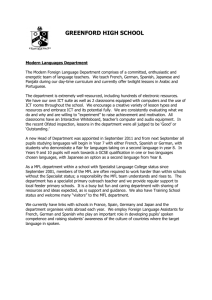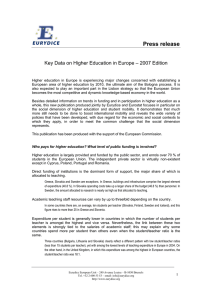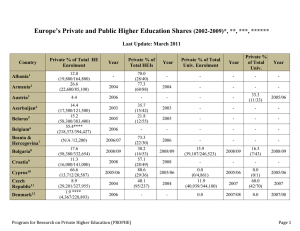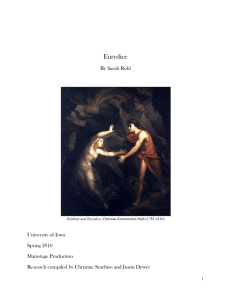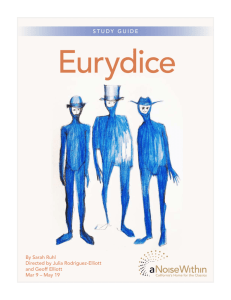DOC
advertisement
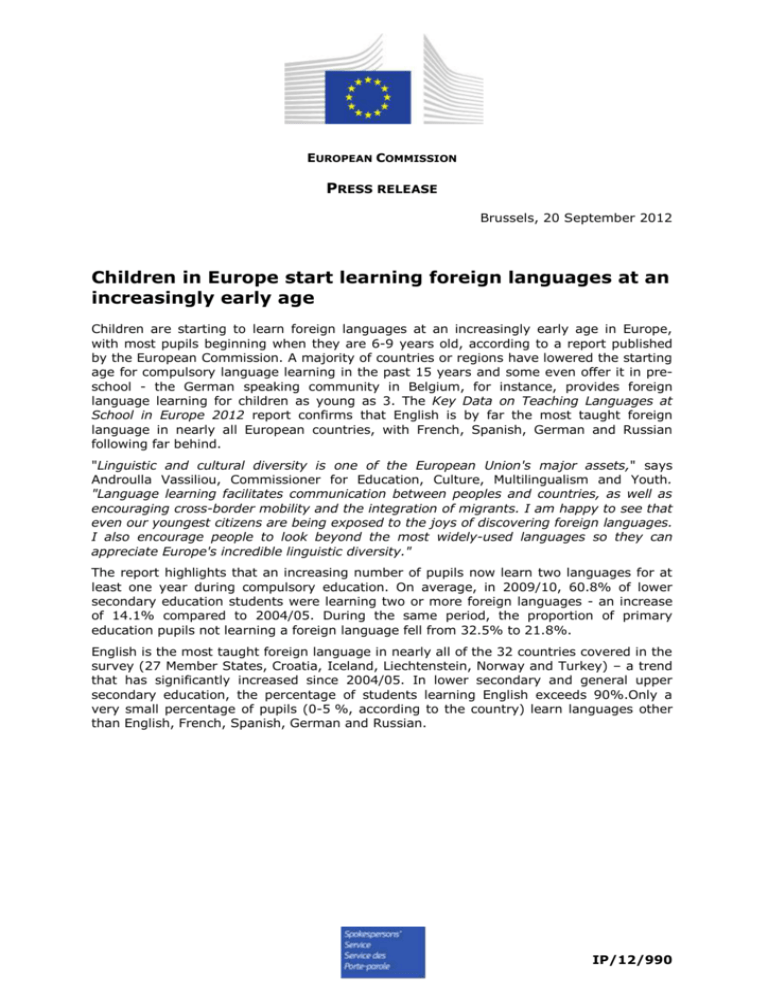
EUROPEAN COMMISSION PRESS RELEASE Brussels, 20 September 2012 Children in Europe start learning foreign languages at an increasingly early age Children are starting to learn foreign languages at an increasingly early age in Europe, with most pupils beginning when they are 6-9 years old, according to a report published by the European Commission. A majority of countries or regions have lowered the starting age for compulsory language learning in the past 15 years and some even offer it in preschool - the German speaking community in Belgium, for instance, provides foreign language learning for children as young as 3. The Key Data on Teaching Languages at School in Europe 2012 report confirms that English is by far the most taught foreign language in nearly all European countries, with French, Spanish, German and Russian following far behind. "Linguistic and cultural diversity is one of the European Union's major assets," says Androulla Vassiliou, Commissioner for Education, Culture, Multilingualism and Youth. "Language learning facilitates communication between peoples and countries, as well as encouraging cross-border mobility and the integration of migrants. I am happy to see that even our youngest citizens are being exposed to the joys of discovering foreign languages. I also encourage people to look beyond the most widely-used languages so they can appreciate Europe's incredible linguistic diversity." The report highlights that an increasing number of pupils now learn two languages for at least one year during compulsory education. On average, in 2009/10, 60.8% of lower secondary education students were learning two or more foreign languages - an increase of 14.1% compared to 2004/05. During the same period, the proportion of primary education pupils not learning a foreign language fell from 32.5% to 21.8%. English is the most taught foreign language in nearly all of the 32 countries covered in the survey (27 Member States, Croatia, Iceland, Liechtenstein, Norway and Turkey) – a trend that has significantly increased since 2004/05. In lower secondary and general upper secondary education, the percentage of students learning English exceeds 90%.Only a very small percentage of pupils (0-5 %, according to the country) learn languages other than English, French, Spanish, German and Russian. IP/12/990 The report also confirms a rather surprising finding - few countries require their trainee language teachers to spend an immersion period abroad. Indeed, only 53.8 % of foreign language teachers who took part in the recently published European Survey on Language Competences (IP/12/679) stated they have spent more than a month studying in a country where the language they teach is spoken. But this average masks a wide variation of approaches: 79.7% of Spanish teachers have spent more than one month studying their chosen language in a country where it is spoken, while this applies to only 11% of Estonian teachers . These findings raise the question of whether exposing future teachers to on-the-ground experience of using the language should be considered as a quality criterion in teacher training. The importance of language learning will be a focus of the 'Multilingualism in Europe' conference, which the Commission is organising in Limassol, Cyprus, on 26-28 September. Commissioner Vassiliou will deliver the keynote speech. Background Multilingualism in the EU The European Commission fosters multilingualism and language learning in order to 1) promote intercultural dialogue and a more inclusive society; 2) help the public to develop a sense of EU citizenship; 3) open up opportunities for young people to study and work abroad and 4) open up new markets for EU businesses competing at the global level. The goal is a Europe where everyone is taught at least two languages in addition to their own mother tongue from a very early age. The 'mother-tongue +2' objective was set by EU heads of state and government at the Barcelona Summit in March 2002. To encourage progress towards this goal, the Commission's new 'Rethinking Skills' strategy, due to be adopted in November, will propose a benchmark on language learning. 'Key Data on Teaching Languages at School in Europe 2012' The report shows that most countries have lowered the starting age for compulsory language learning in the past 15 years, with the exception of Belgium (French-speaking community), Latvia, Luxembourg, Hungary, Malta, Netherlands, Finland, Sweden and the UK. While the age of students starting to learn a foreign language has decreased in general, the amount of teaching time they receive has not significantly increased. Indeed, teaching time dedicated to foreign languages is rather low compared to other subjects. Key Data on Teaching Languages at School in Europe 2012 provides comprehensive evidence to support policy-making and to improve the quality and efficiency of language learning. Promotion of language learning is one of the main objectives of the Commission's Education and Training (ET 2020) strategy, and also crucial for encouraging the crossborder mobility of EU citizens, which is one of the aims of the Europe 2020 strategy for jobs and growth. Produced every 3-4 years, the report brings together a variety of data sources and provides a complete picture of language teaching in the 32 participating countries It measures 61 indicators in five categories: context, organisation, participation, teachers and teaching processes. The data is mainly drawn from four sources: Eurydice, Eurostat, the European Survey on Language Competences, and the OECD's PISA (Programme for International Student Assessment) international survey. 2 It combines this statistical data with a description of the context and organisation of foreign language teaching, student participation levels as well as details of the initial and continuing education of foreign language teachers. In addition, the report also presents trends in language teaching over the years and analyses the present situation in comparison with the past. . Key Data on Teaching Languages at School in Europe 2012 is a joint Eurydice/Eurostat publication, produced in close cooperation with the European Commission. Eurydice The Eurydice network provides analyses and information on European education systems and policies. It consists of 38 national units based in the 34 countries which participate in the EU's Lifelong Learning Programme (EU Member States, Croatia, Serbia, Iceland, Liechtenstein, Norway, Switzerland and Turkey). Serbia and Switzerland did not take part in the Key Data on Teaching Languages at School in Europe 2012 report. Eurydice is coordinated and managed by the EU Education, Audiovisual and Culture Executive Agency. For more information The full report, in English is available here: Key Data on Teaching Languages at School in Europe 2012 Highlights of the report European Commission: Education and training Androulla Vassiliou's website Follow Androulla Vassiliou on Twitter @VassiliouEU Contacts : Dennis Abbott (+32 2 295 92 58); Twitter: @DennisAbbott Dina Avraam (+32 2 295 96 67) 3 Starting ages for the first and second foreign languages as compulsory subjects for all students in pre-primary, primary and/or general secondary education, 2010/11 Specific mandatory foreign languages as specified by central education authorities (at one point during full-time compulsory education), 1992/93, 2002/03, 2006/07, 2010/11 4 Percentage of all students in primary education who are learning English, French and/or German. Countries in which one of these languages is the most widely learnt, 2009/10 Foreign languages other than German, English, Spanish, French and Russian learnt by students in secondary education, as a percentage of all languages learnt at this level, 2009/10 5 Existence of recommendations on the content of initial teacher education and the immersion period spent in the target language country, 2010/11 6
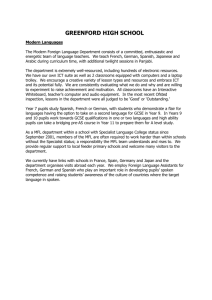

![afl_mat[1]](http://s2.studylib.net/store/data/005387843_1-8371eaaba182de7da429cb4369cd28fc-300x300.png)
